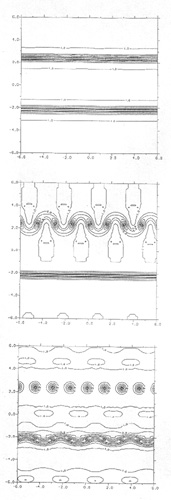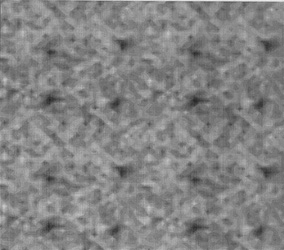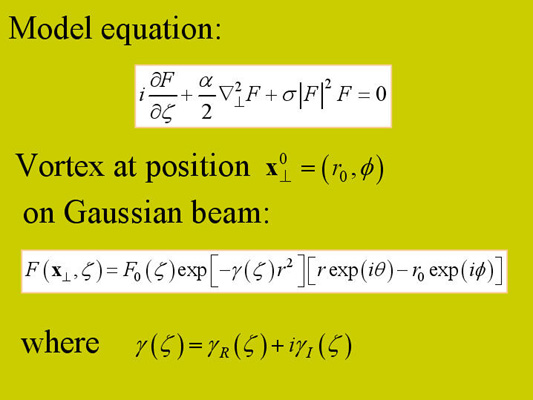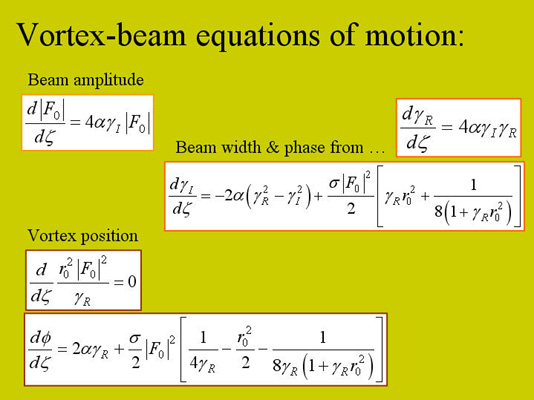Optical vortex solitons
The work below includes the discovery of optical vortex streets & optical vortex trajectory rotations & optical vortex arrays.
Optical vortex soliton: streets (1D) & arrays (2D)
Optical vortex street
|
|
Optical vortex array
|
|
Linear Beams with Vorticity & Angular Momentum
5. S Chavez-Cerda, GS McDonald and GHC New, Nondiffracting Beams: Travelling, Standing, Rotating and Spiral Waves, Opt Commun 123 (1996) 225.
Abstract. A reformulation of nondiffracting beams, based on more general (travelling wave) solutions of the nonparaxial wave equation, is presented. Zero order nondiffracting beams are found to be radial standing waves arising from counterpropagating zero order Hankel waves of the first and second kind, while higher order nondiffracting beams are formed from counter-rotating spiral waves which are described by Hankel functions of the corresponding order. The resulting physical picture is more general than the well-known integral representation of Bessel functions and we expect it to have implications for studies of the applications of nondiffracting beams. Generic descriptions of the transverse profiles of the electric field, applicable to experimental configurations for realising nondiffracting beams, follow directly from this formulation. Finally, the existence of classes of periodically nondiffracting beams, possessing finite angular momentum and having the characteristics of rotating and spiral waves, is predicted.
Nonlinear Beams with Vorticity & Angular Momentum
4. GS McDonald, KS Syed and WJ Firth, Dark Spatial Soliton Break-up in the Transverse Plane, Opt Commun 95 (1993) 281.
Abstract. We report on numerical simulations investigating the instabilities which arise when dark soliton solutions of the two-dimensional (2D) nonlinear Schrodinger equation are allowed to propagate in a 3D self-defocusing medium. Firstly, propagation of fully 3D Gaussian beams is studied. Then, on plane background, small sinusoidal and random perturbations are considered. We demonstrate break-up of the dark soliton profile into patterns of dark spots which are identified as phase singularities.
3. GS McDonald, KS Syed and WJ Firth, Optical Vortices in Beam Propagation Through a Self-Defocussing Medium Opt Commun 94 (1992) 469.
Abstract. We present numerical simulations and analysis of optical vortex propagation in a 3D self-defocusing medium. On plane wave background initial conditions composed of points and lines of phase discontinuity are shown, in some cases, to evolve towards a regular crystal of fully nonlinear vortices. In other cases the solution more resembles a vortex gas. For Gaussian beams we have derived a simple set of ordinary differential equations which are shown to accurately describe the motion of a single vortex while the background beam undergoes significant spreading.
Optical vortex solitons: equations of motion (on a beam)
Due to typographical error in the original paper, the corrected vortex equations of motion are given here:
Optical vortex on Gaussian beam
|
|
Optical vortex equations of motion
|
2. GS McDonald, KS Syed and WJ Firth, Dark Soliton Break-Up and Optical Vortices in the 3D Nonlinear Schrodinger Equation, International Quantum Electronics Conference, Vienna, Austria, June 14-19, 1992.
1. KS Syed, Optical Vortices and Spatial Dark Solitons in Passive Nonlinear Media, MSc Dissertation (Supervisor: GS McDonald, Strathclyde University, October 1991).
Important Note
Credit for independent discovery of some of the above key results must also be given to GA Swartzlander's group. See this work, which appeared in October 1992.